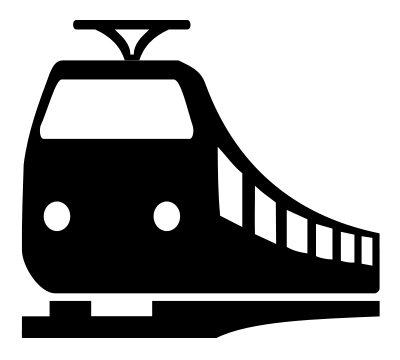
This image has format transparent PNG with resolution 400x360.
You can download this image in best resolution from this page and use it for design and web design.
Train PNG with transparent background you can download for free, just click on download button.
A train is a form of rail transport consisting of a series of connected vehicles that generally run along a railroad (or railway) track to transport passengers or cargo (also known as "freight" or "goods"). The word "train" comes from the Old French trahiner, derived from the Latin trahere meaning "to pull" or "to draw".
Motive power for a train is provided by a separate locomotive or individual motors in a self-propelled multiple unit. The term "engine" is often used as an alternative to locomotive. Although historically steam propulsion dominated, the most common types of locomotive are diesel and electric, the latter supplied by overhead wires or additional rails. Trains can also be hauled by horses, pulled by engine or water-driven cable or wire winch, run downhill using gravity, or powered by pneumatics, gas turbines or electric batteries.
The track usually consists of two running rails with a fixed spacing, which may be supplemented by additional rails such as electric conducting rails ("third rail") and rack rails. Monorails and maglev guideways are also occasionally used.
Passenger trains include passenger-carrying vehicles and can often be very long and fast. High-speed rail systems began expanding rapidly in the late 20th century, and this remains a major subject of further development. The term "light rail" is sometimes used to refer to a modern tram system, but it may also mean an intermediate form between a tram and a train, similar to a heavy rail rapid transit system.
Freight (goods) trains use freight cars (or wagons/trucks) to transport goods or materials (cargo). It is possible to carry passengers and freight in the same train using a mixed consist.
Rail cars and machinery that are used for the maintenance and repair of tracks, are termed "maintenance of way" equipment; these may be assembled into maintenance of way trains. Similarly, dedicated trains may be used to provide support services to stations along a train line, such as garbage or revenue collection.
There are various types of trains that are designed for particular purposes. A train can consist of a combination of one or more locomotives and attached railroad cars, or a self-propelled multiple unit, or occasionally a single or articulated powered coach called a railcar. Special kinds of train running on corresponding purpose-built "railways" are monorails, high-speed railways, maglev, atmospheric railways, rubber-tired underground, funicular and cog railways.
A passenger train consists of one or more locomotives and (usually) several coaches. Alternatively, a train may consist entirely of passenger-carrying coaches, some or all of which are powered; this is known as a "multiple unit". In many parts of the world, particularly the Far East and Europe, high-speed rail is used extensively for passenger travel. Freight trains consist of cars, wagons or trucks rather than carriages, though some parcel and mail trains (especially Travelling Post Offices) appear outwardly to be more like passenger trains. Trains can also have mixed consist, with both passenger accommodation and freight vehicles. These mixed trains are most likely to be used for services that run infrequently, where the provision of separate passenger and freight trains would not be cost-effective, but the disparate needs of passengers and freight means that this is avoided where possible. Special trains are also used for track maintenance; in some places, this is called "maintenance of way".
In the United Kingdom, a train hauled using two locomotives is known as a "double-headed" train. In Canada and the United States, it is quite common for a long freight train to be headed by three or more locomotives. A train with a locomotive attached at both ends is described as "top and tailed", this practice typically being used when there are no reversing facilities available. Where a second locomotive is attached temporarily to assist a train when ascending steep banks or gradients (or to provide braking power for a descent), this is referred to as "banking" in the UK. Many loaded trains in the US are assembled using one or more locomotives in the middle or at the rear of the train, which are then operated remotely from the lead cab. This is referred to as "DP" or "Distributed Power."
In this page you can download free PNG images: Train PNG images free download